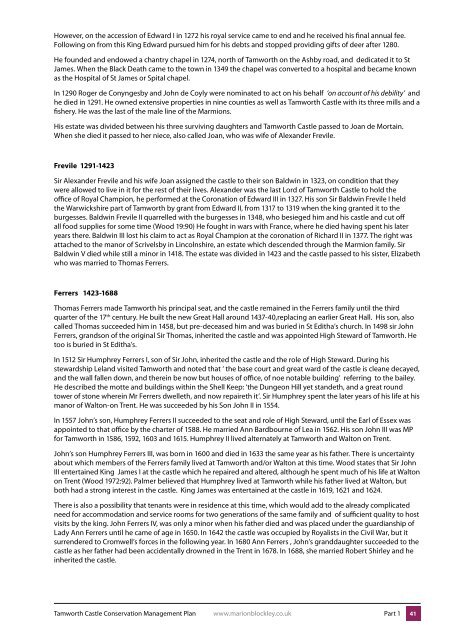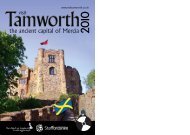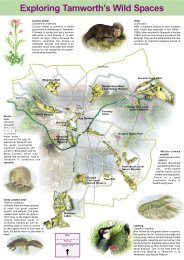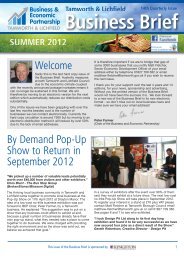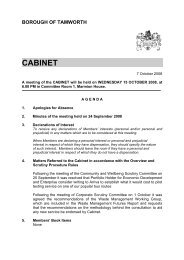Conservation Management Plan - Tamworth Borough Council
Conservation Management Plan - Tamworth Borough Council
Conservation Management Plan - Tamworth Borough Council
Create successful ePaper yourself
Turn your PDF publications into a flip-book with our unique Google optimized e-Paper software.
However, on the accession of Edward I in 1272 his royal service came to end and he received his final annual fee.<br />
Following on from this King Edward pursued him for his debts and stopped providing gifts of deer after 1280.<br />
He founded and endowed a chantry chapel in 1274, north of <strong>Tamworth</strong> on the Ashby road, and dedicated it to St<br />
James. When the Black Death came to the town in 1349 the chapel was converted to a hospital and became known<br />
as the Hospital of St James or Spital chapel.<br />
In 1290 Roger de Conyngesby and John de Coyly were nominated to act on his behalf ‘on account of his debility’ and<br />
he died in 1291. He owned extensive properties in nine counties as well as <strong>Tamworth</strong> Castle with its three mills and a<br />
fishery. He was the last of the male line of the Marmions.<br />
His estate was divided between his three surviving daughters and <strong>Tamworth</strong> Castle passed to Joan de Mortain.<br />
When she died it passed to her niece, also called Joan, who was wife of Alexander Frevile.<br />
Frevile 1291-1423<br />
Sir Alexander Frevile and his wife Joan assigned the castle to their son Baldwin in 1323, on condition that they<br />
were allowed to live in it for the rest of their lives. Alexander was the last Lord of <strong>Tamworth</strong> Castle to hold the<br />
office of Royal Champion, he performed at the Coronation of Edward III in 1327. His son Sir Baldwin Frevile I held<br />
the Warwickshire part of <strong>Tamworth</strong> by grant from Edward II, from 1317 to 1319 when the king granted it to the<br />
burgesses. Baldwin Frevile II quarrelled with the burgesses in 1348, who besieged him and his castle and cut off<br />
all food supplies for some time (Wood 19:90) He fought in wars with France, where he died having spent his later<br />
years there. Baldwin III lost his claim to act as Royal Champion at the coronation of Richard II in 1377. The right was<br />
attached to the manor of Scrivelsby in Lincolnshire, an estate which descended through the Marmion family. Sir<br />
Baldwin V died while still a minor in 1418. The estate was divided in 1423 and the castle passed to his sister, Elizabeth<br />
who was married to Thomas Ferrers.<br />
Ferrers 1423-1688<br />
Thomas Ferrers made <strong>Tamworth</strong> his principal seat, and the castle remained in the Ferrers family until the third<br />
quarter of the 17 th century. He built the new Great Hall around 1437-40,replacing an earlier Great Hall. His son, also<br />
called Thomas succeeded him in 1458, but pre-deceased him and was buried in St Editha’s church. In 1498 sir John<br />
Ferrers, grandson of the original Sir Thomas, inherited the castle and was appointed High Steward of <strong>Tamworth</strong>. He<br />
too is buried in St Editha’s.<br />
In 1512 Sir Humphrey Ferrers I, son of Sir John, inherited the castle and the role of High Steward. During his<br />
stewardship Leland visited <strong>Tamworth</strong> and noted that ‘ the base court and great ward of the castle is cleane decayed,<br />
and the wall fallen down, and therein be now but houses of office, of noe notable building’ referring to the bailey.<br />
He described the motte and buildings within the Shell Keep: ‘the Dungeon Hill yet standeth, and a great round<br />
tower of stone wherein Mr Ferrers dwelleth, and now repaireth it’. Sir Humphrey spent the later years of his life at his<br />
manor of Walton-on Trent. He was succeeded by his Son John II in 1554.<br />
In 1557 John’s son, Humphrey Ferrers II succeeded to the seat and role of High Steward, until the Earl of Essex was<br />
appointed to that office by the charter of 1588. He married Ann Bardbourne of Lea in 1562. His son John III was MP<br />
for <strong>Tamworth</strong> in 1586, 1592, 1603 and 1615. Humphrey II lived alternately at <strong>Tamworth</strong> and Walton on Trent.<br />
John’s son Humphrey Ferrers III, was born in 1600 and died in 1633 the same year as his father. There is uncertainty<br />
about which members of the Ferrers family lived at <strong>Tamworth</strong> and/or Walton at this time. Wood states that Sir John<br />
III entertained King James I at the castle which he repaired and altered, although he spent much of his life at Walton<br />
on Trent (Wood 1972:92). Palmer believed that Humphrey lived at <strong>Tamworth</strong> while his father lived at Walton, but<br />
both had a strong interest in the castle. King James was entertained at the castle in 1619, 1621 and 1624.<br />
There is also a possibility that tenants were in residence at this time, which would add to the already complicated<br />
need for accommodation and service rooms for two generations of the same family and of sufficient quality to host<br />
visits by the king. John Ferrers IV, was only a minor when his father died and was placed under the guardianship of<br />
Lady Ann Ferrers until he came of age in 1650. In 1642 the castle was occupied by Royalists in the Civil War, but it<br />
surrendered to Cromwell’s forces in the following year. In 1680 Ann Ferrers , John’s granddaughter succeeded to the<br />
castle as her father had been accidentally drowned in the Trent in 1678. In 1688, she married Robert Shirley and he<br />
inherited the castle.<br />
<strong>Tamworth</strong> Castle <strong>Conservation</strong> <strong>Management</strong> <strong>Plan</strong> www.marionblockley.co.uk<br />
Part 1<br />
41


